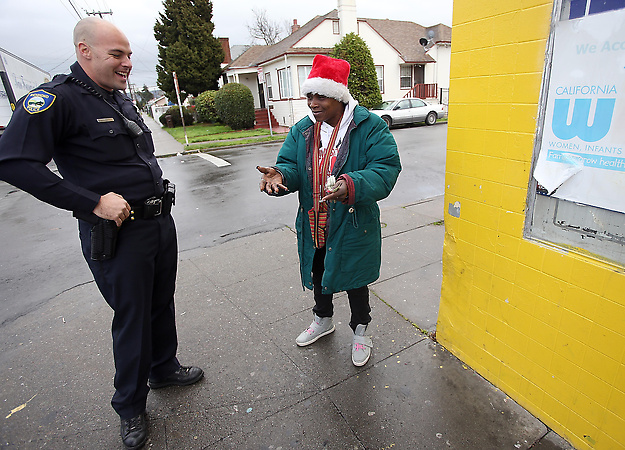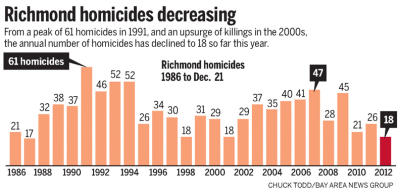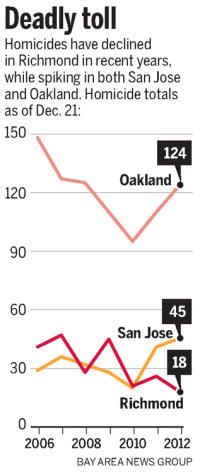| |
Homicides plummet in Richmond, once considered among the most dangerous cities in U.S.
By Robert Rogers Contra Costa Times
Posted: 12/24/2012 12:01:00 AM PST
 

1 of 12
Richmond police ride-along
Officer Matt Stonebraker talks with Sharon Miller, of Richmond, on the corner of Bissell Avenue and 15th Street in Richmond, Calif. on Friday, Dec. 21, 2012. According to recent statistics, crime is down in Richmond the past few years. There have been 16 homicides in the city so far this year. (Jane Tyska/Staff)
.

Related
RICHMOND -- As Oakland, San Francisco and San Jose grapple with rising homicide totals and fears that their police departments are ill-equipped to stem the tide, a different reality has taken shape in this city once labeled among the most dangerous in the nation.
Eighteen people have been killed in Richmond this year, down from 45 three years ago and about half as many as the yearly average over the past decade. Many credit the turnaround to a confluence of law enforcement and community efforts since a summer of bloodshed in 2005 that led to calls for the city to declare a state of emergency.
While strained resources in police departments and social services have hampered public safety efforts in other Bay Area cities, Richmond has bulked up its police force from 150 sworn officers in 2006 to 190 today, implemented modern community-policing models and funded a novel violence-prevention office.
The results can be seen all over Richmond's craggy streets. Parks once prowled by drug pushers and gun toters now bustle with kids. Violent tracts, where gunfire and sirens once ushered in the Tent City peace movement, now host dog walkers and cyclists.
The total crime rate is down about 20 percent since 2006. The last time the city finished a year with homicide numbers this low was 2001.
"Richmond is doing a lot of things right, and that's helping them buck a trend," said Barry Krisberg, research and policy director at the Earl Warren Institute at UC Berkeley School of Law. "Years ago, Richmond committed itself to an evidence-based, comprehensive strategy to reduce violence, and we're seeing the payoff."
With 103,000 people, Richmond still has a higher per-capita homicide rate than cities like San Francisco or San Jose, but the days of making "most dangerous in the country" lists -- Richmond was in the top 10 as recently as 2007 -- seem like a distant memory.
"Back (in the mid-2000s), the violence had taken

over," said Otheree Christian, president of the Iron Triangle Neighborhood Council. "Now, people are hopeful and empowered."
The historic lows in Richmond contrast with recent spikes in San Jose, where the homicide total this year is more than double the figure from 2010, and San Francisco, which has also seen a big jump in 2012. Oakland is once again well above 100 slayings for the year.
Some trace Richmond's new dawn to a summer night in 2005. Reeling from eight homicides and a fusillade of shootings in the days before, hundreds packed the Richmond City Council chamber to demand action. Many pleaded for the National Guard.
That didn't happen, but over the next few years, clergy and grass-roots groups rallied, and the city freed up millions of dollars for crime-prevention initiatives and police funding.
A devotee to modern community policing -- he says his greatest asset is "relationships" with the community -- police Chief Chris Magnus has remade the department from one that emphasized aggressive crime-suppression teams to one keyed on resident involvement and preventive action. Magnus has deployed technologies like gunshot-detection systems and surveillance cameras, and has made Compstat, a process of data mapping and analysis, crucial to resource-deployment strategies.
The efforts go beyond policing, though. The city's influential network of African-American clergy and neighborhood activists have gone door to door by streetlight in the toughest neighborhoods. And the Office of Neighborhood Safety, the only one of its kind in the region, employs agents who build relationships with more than 50 young men and teens, identified through criminal records and other data as potential violent offenders. The program includes educational, counseling and job-placement support in exchange for ceasing criminal activity.
"People can't believe that this city has set aside money and resources to reach out to young people involved in gun violence in a way other than through law enforcement," said Office of Neighborhood Safety Director Devone Boggan.
Still, some of Richmond's gains may stem from uncontrollable factors and even luck.
"You want to be cautious when pinning the tail on the causes for declines in Richmond homicides," said UC Berkeley criminologist Franklin Zimring. "They are doing community-based policing, but they are also doing intensive policing, with a lot of cops on the streets."
Veteran Richmond officers warn that street crime can ramp up any moment. Historically, a small group of prolific shooters have launched brief, intense sprees, sparking bloodshed that pushes crime statistics sky-high. They cite the 45 homicides in 2009 as the most recent aberration. That year, police say, a group of teens with assault weapons mounted with laser sights, dubbed "The Beam Team," unleashed a rampage.
The city saw its record for homicides, 61, in 1991, just four years removed from the 17 killings in 1987, the lowest total since 1980.
Time will tell whether this is another calm between storms or a permanent shift in the city's long-standing crime woes. But, for now, it appears Richmond's decadelong war on crime has paid big dividends.
"We have come a long way, and it all started with those efforts of clergy and dedicated anti-violence voices that demanded action as far back as 2003," said the Rev. Andre Shumake, one of the city's leading anti-violence voices. "We demanded policy shifts and investments in intervention and prevention. ... When I see the ministers that worked with us, I smile and say, 'Look at the fruits of our labors.'"
Contact Robert Rogers at 510-262-2726 and follow him at Twitter.com/roberthrogers.
|
|

